1. Feeding
Beaks and to some extent feet, provide birds with the means to to obtain their food and because birds have no teeth, beaks are the tools they use to prepare their food for swallowing and digestion. Beaks differ a lot in shape and size according to the bird's diet and how it obtains food. Here are a few examples.
Carnivores
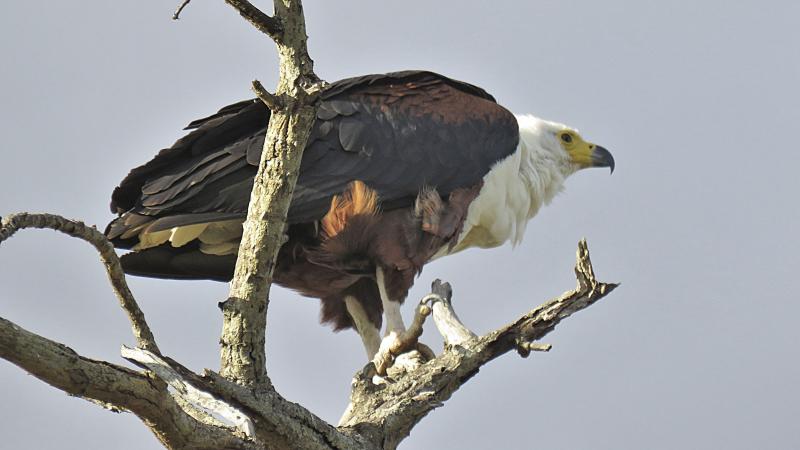
African Fish Eagle
The magnificent Fish Eagle, photographed above in the Kruger National Park, South Africa, is at the top of the food chain and has the powerful hooked beak and fearsome talons of the alpha predator. African fish eagles are found near lakes, rivers, estuaries and on the coast in Namibia. Fish is an important part of their diet. However, they also prey on birds, turtles, lizards, frogs, and even baby crocodiles! Occasionally, they may even carry off mammalian prey, such as hyraxes and monkeys. Fish eagles take their prey by gripping them in their talons and tearing them into manageable portions with their beaks.
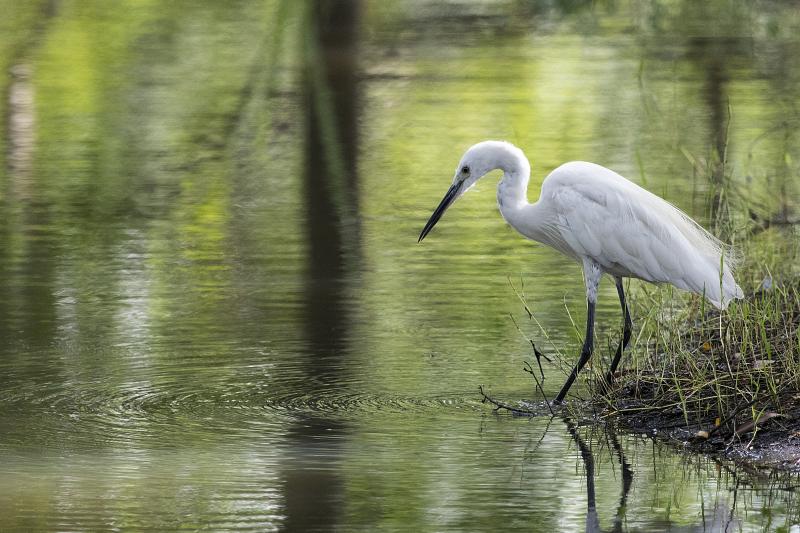
Little Egret
Fishing with feet
I have often wondered why a wader with a black beak and black legs should have yellow feet. Then one day I was watching the lesser egret in the picture above looking for lunch at Suan Rot Fai, a park in Bangkok, Thailand. The egret dipped its left leg in the water and began a rapid vibrating action, creating the rings visible in the picture. I realised that it was using its bright yellow foot as a lure presumably for fish.
Skillful Hunting
Little egrets are talented hunters with a wide repertoire of techniques: they will stand frozen waiting for prey, in or out of the water, to come close enough for them to strike; they will chase fish or amphibians in the water or reptiles, small mammals and birds on land. Their long legs are a valuable advantage for wading and running while their long, sharp beaks are deadly weapons to spear prey which is swallowed whole. Shellfish, insects, worms, spiders and crustacean are also on the menu.
Piscivores

White-breasted Cormorant
The white-breasted cormorants above are good examples of a type of carnivore that feeds solely on a diet of fish. They are perfectly adapted to this way of feeding with long, thin hooked beaks, webbed feet and short wings that enable them to dive and move efficiently under water. They use both feet and wings to propel themselves through the water. Most piscivores are marine species although I photographed these cormorants on Bo-Langvlei, a freshwater lake close to the sea near Wilderness, Western Cape, South Africa.
Insectivores
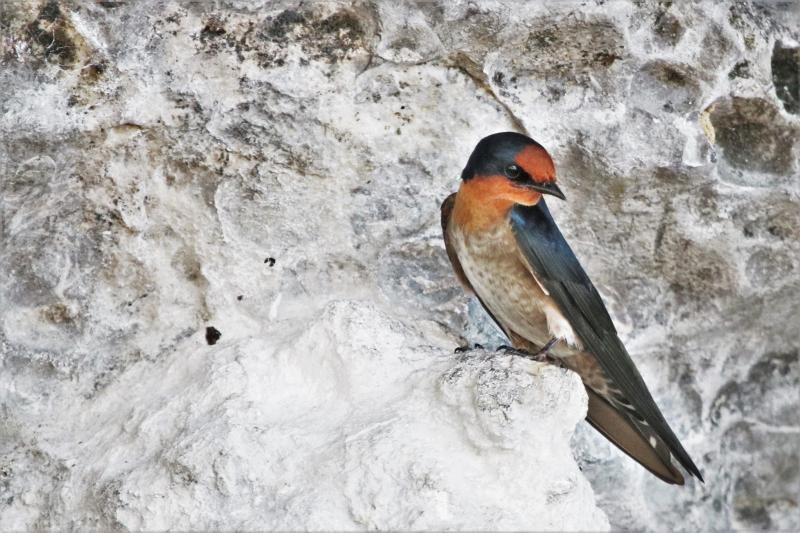
Pacific Swallow
Different bird species hunt insects in different ways. Some birds catch insects in flight and many of us have enjoyed the aerial acrobatics of swallows and swifts as they chase insects on the wing. Their flat v-shaped beaks when open allow them to make the most of this method of feeding. The pacific swallow above is resting between hunting expeditions under a limestone overhang on a cliff on Tonsai Beach, Krabi, Thailand, and has the typical beak of this type of insectivore.
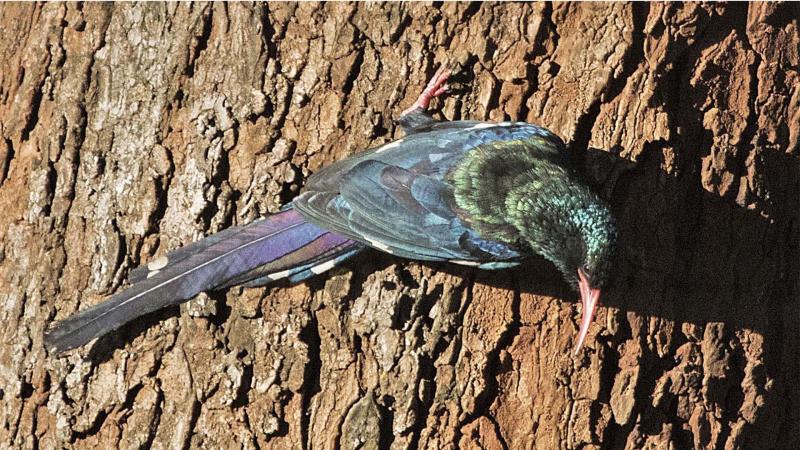
Red-billed Wood Hoopoe
In contrast, insectivores that probe for their prey have thin, long, often strong beaks in order to dig deep into the ground or into the bark of trees. The long curved bill of the red-billed wood hoopoe, photographed in a garden in Harare, Zimbabwe, is well suited to seeking out insects and grubs in the rotting bark of trees.
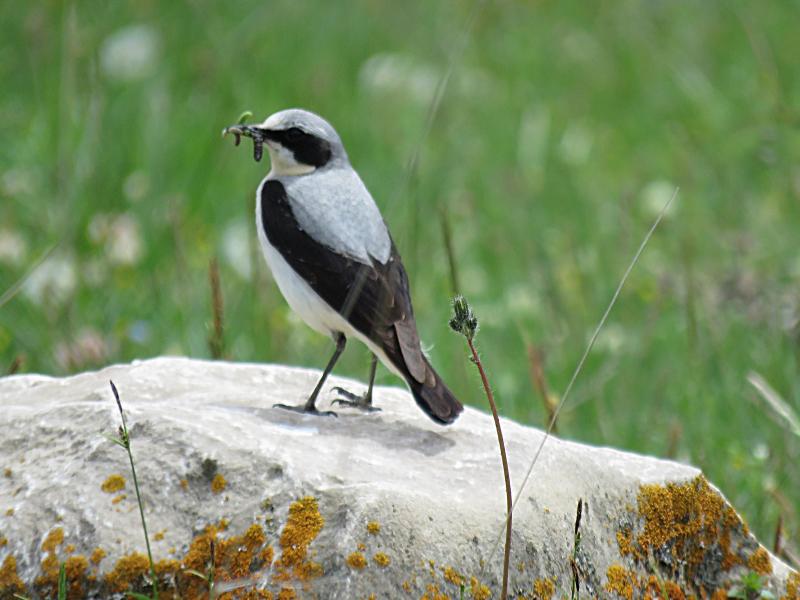
Northern Pied Wheatear
Birds that take insects that are above ground but not in flight tend to have shorter, straight, thin beaks. The Northern pied wheatear in the Caucasus Mountains, Lahic, Azerbaijan (above) has collected juicy caterpillars to feed a hungry family.
Granivores
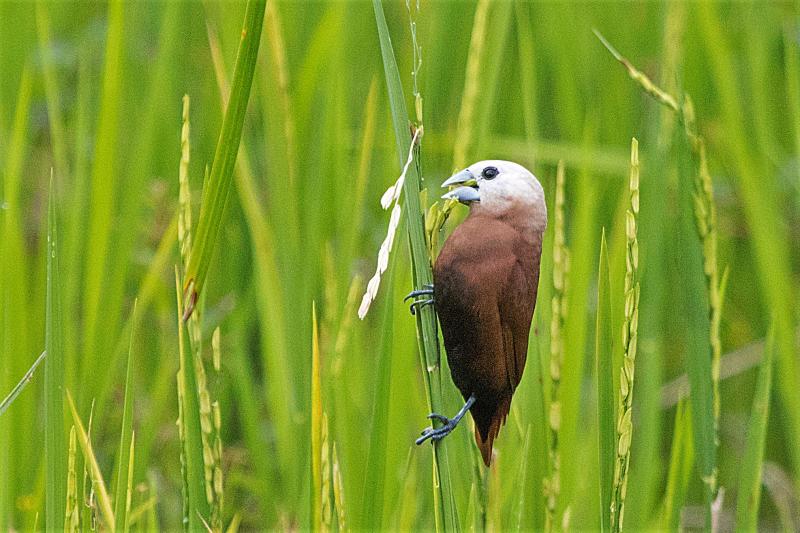
White-headed Munia
Granivores have strong, short, rounded beaks specially adapted to breaking open seeds. The white-headed munia in the picture above is one of a flock that was feeding on a rice crop in a field on Samosir Island, Lake Toba, Sumatra. Farmers consider the several species of munia as pests and will expend a lot of time and effort trying to drive them away from their crops.
Nectarivores

Greater Double-collared Sunbird
Nectarivors insert their long, thin beaks into flowers to extract the nectar. The shape of the beak varies according to the kind of flowers they feed on. They are pollinators and have a symbiotic relationship with flowers. In other words, both flowers and birds benefit from the work of these specialised feeders. The photograph above shows a beautiful greater double-collared sunbird sucking nectar from a red hot poker flower in George Botanic Gardens, Western Cape. Or is our sunbird after the ants visible higher up the red hot poker? Sunbirds are insectivores as well as nectarivores. As with human beings, categorising and labelling birds has its limitations.
Frugivores
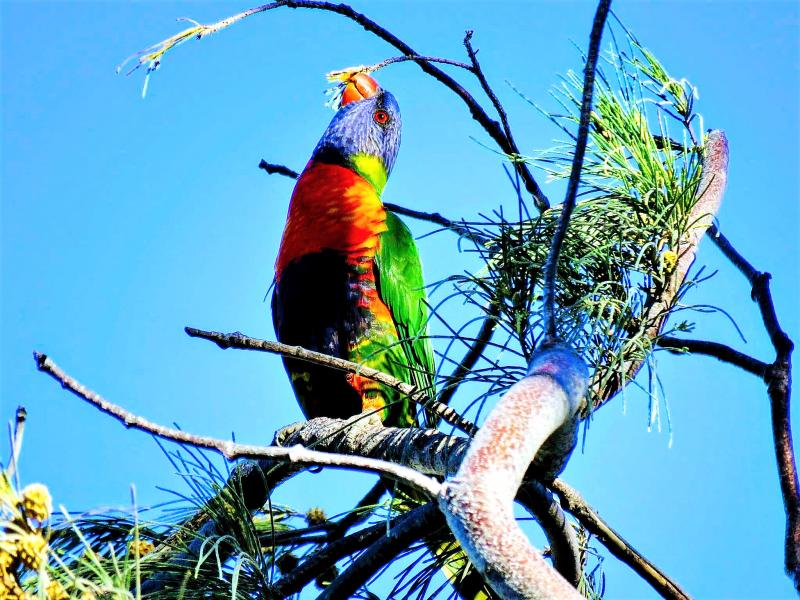
Rainbow Lorokeet
The spectacular rainbow Lorokeet above, photographed in Toowoomba, Queensland, Australia, has the typical frugivore's short, curved beak with a hooked tip which is the perfect tool for opening fruit to obtain the pulp and seeds. The lower mandible is flat and sharp, ideal for splitting hard fruits. They are equally well equipped as granivores so they enjoy a mixed diet of fruit and seeds. The parrots, parakeets, lorokeets, cockatoos and macaws are the only group of birds that can move the upper mandible separately from the lower mandible This allows them to exert extra pressure for breaking into fruit and seeds and also for gripping branches.
Omnivores
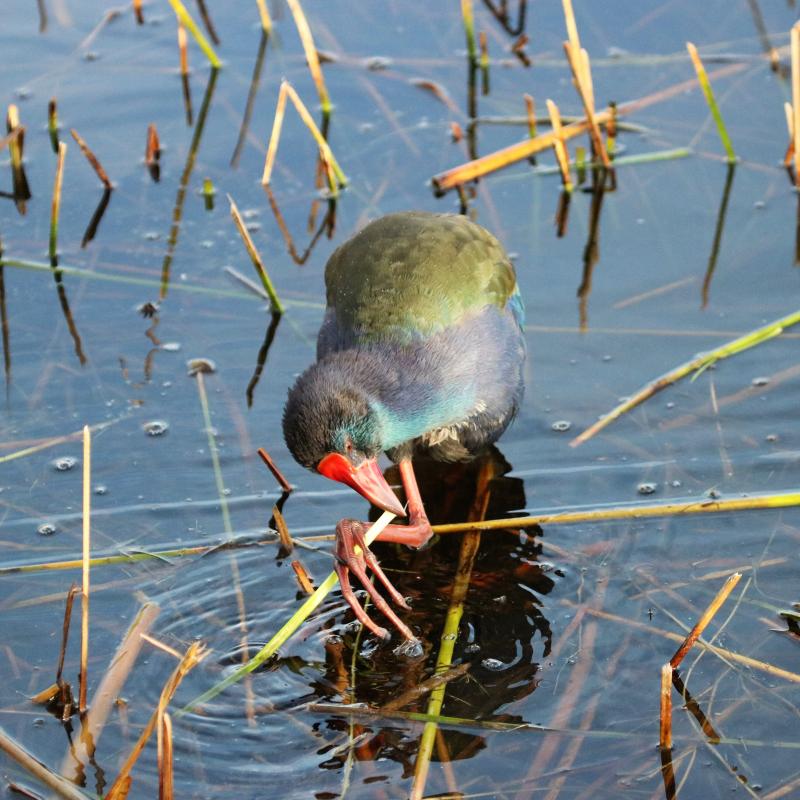
Purple Swamphen
The purple swamphen phtographed at Langvlei, Sedgefield, Western Cape looks like a typical herbivore feeding on the juicy soft underwater shoots and stems of reeds and rushes. I was certainly convinced as I watched for an hour while it pulled up the reeds with its beak to access the new hidden growth and then used its long feet to cleverly grasp the shoots and nibble from one end to the other. (I realised where science fiction film makers got their idea for alien hands!) However, later research revealed the shocking truth. The purple swamphen is a predator using its large, sharp, dangerous looking beak to prey on frogs and snails, to steal the eggs of other species and, when opportunity arises, to snatch innocent duckings. A true omnivore.
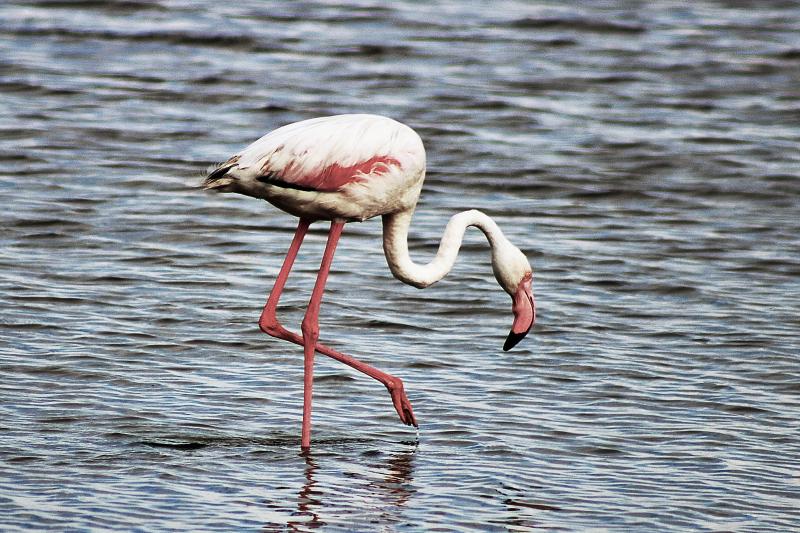
Greater Flamingo
Flamingoes like baleen whales, krill, clams, sponges, and many species of fish are filter feeders. This elegant greater flamingo in the photograph is one amongst thousands that gather to feed at Walvis Bay, Namibia. The beak is bent in the middle with a large trough-like lower mandible and a small upper mandible like a lid. They feed by using their large feet to stir up the mud which contains their food. They then lower their heads upside down filtering the muddy water as they plough their beaks from side to side. Their thick, fleshy tongues create suction by pumping back and forth like a piston in the lower mandible, expelling the water while fine hairs lining the inside of the mandibles retain diatroms and algae. Extra long legs enable flamingoes to wade in deep water in order to find their food. Their unique beaks also help them to consume shellfish, seeds, crustaceans, and insects so they can be classified as omnivores.

Yellow-billed Duck
The yellow-billed duck featured above on small lake on Thesen Island, Western Cape, South Africa, is a dabbling duck. Dabbling ducks are easily recognised. When they are feeding in shallow water their heads and much of their bodies are under water leaving their bottom half raised vertically above the water. Yellow-billed ducks propel themselves through the water on webbed feet and use their flat spade-shaped beaks to shovel up aquatic plants insects and larvae while expelling water through small holes at the sides of their beaks. However, their diet also consists of seeds, molluscs and crustacieans.
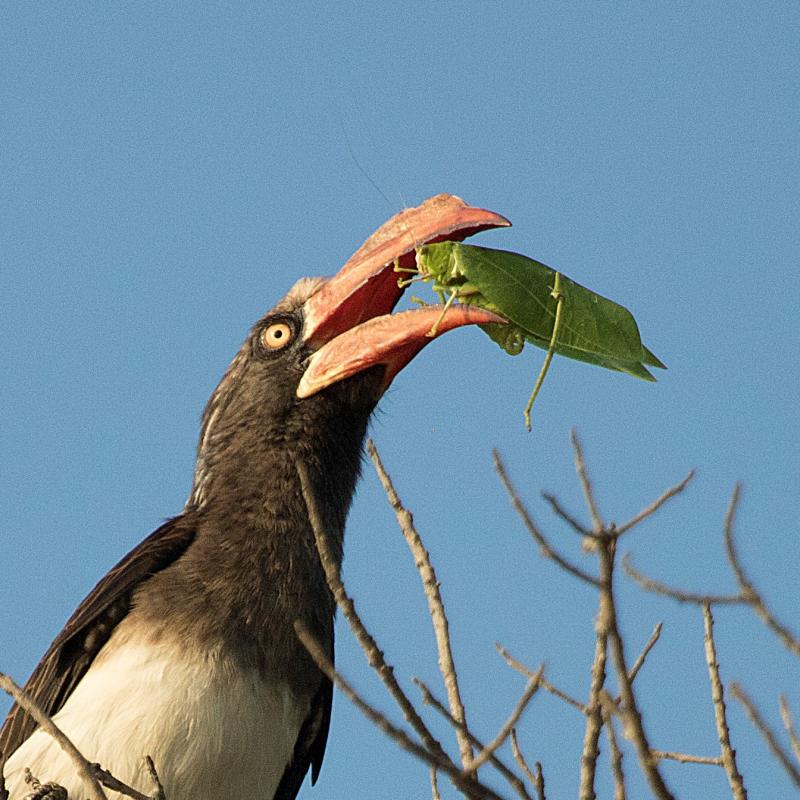
Crowned Hornbill
How to Eat a Grasshopper
I spotted this African crowned hornbill one afternoon while walking back from a remote beach on Incaha Island, Mozambique. It was gripping a large grasshopper in its mouth while perched in a tree which luckily had no leaves allowing an excellent view. A few seconds later it flipped the unfortunate grasshopper lengthways to its mouth and with a flick of the head, swallowed it whole. As hornbills have short tongues, food at the tip of the beak has to be tossed back to the throat by jerking the head. Hunting mainly from trees, the crowned hornbill will take insects, which it often catches in flight, small birds, rodents, reptiles and amphibians. But it's an omnivore and also forages for wild fruits including figs, berries, rambutans and papya.
Living with a Huge Beak
The strong, powerful beak is well adapted to its varied diet but research has shown that hornbills' huge beaks also transfer heat and help them keep cool. Hornbills have "binocular vision" and are able to focus with both eyes to judge distance. Unlike most birds with binocular vision, their view is impaired by their enormous beaks. The evolutionary advantage for hornbills is that binocular vision enables them to see their own beak tips so they can engage in the sort of precision eating described in the previous paragraph. Coupled with binocular vision hornbills have large eyes which are protected by very large eyelashes.